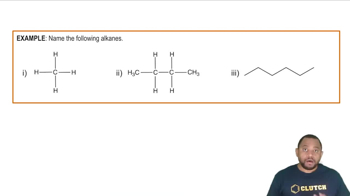Here are the essential concepts you must grasp in order to answer the question correctly.
Alkanes
Alkanes are a class of hydrocarbons characterized by single bonds between carbon atoms. They follow the general formula CnH2n+2, where 'n' is the number of carbon atoms. Alkanes are saturated compounds, meaning they contain the maximum number of hydrogen atoms per carbon atom, and they are typically non-polar and less reactive than other hydrocarbon types.
Recommended video:
Nomenclature of Alkanes
The nomenclature of alkanes follows specific rules set by the International Union of Pure and Applied Chemistry (IUPAC). The names are derived from the number of carbon atoms in the longest continuous chain, with prefixes such as 'meth-' for one carbon, 'eth-' for two, and so on. The suffix '-ane' indicates that the compound is an alkane, helping to distinguish it from other types of hydrocarbons.
Recommended video:
Isomerism in Alkanes
Isomerism refers to the existence of compounds with the same molecular formula but different structural arrangements. In alkanes, this can lead to structural isomers, where the carbon skeleton varies, and positional isomers, where the location of branches or functional groups changes. Understanding isomerism is crucial for naming and identifying different alkanes, as it affects their physical and chemical properties.
Recommended video:
 Verified step by step guidance
Verified step by step guidance


